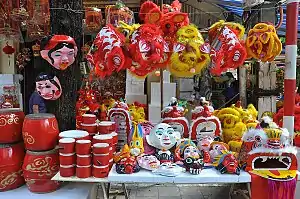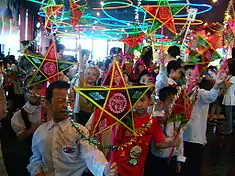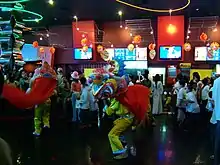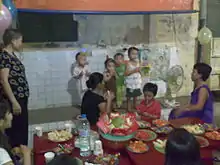Tết Trung Thu
Tết Trung Thu (Chữ Hán: 節中秋) is a traditional Vietnamese festival held from the night of the 14th of the 8th lunar month to the end of the 15th of the 8th lunar month (Rằm tháng Tám). This festival has become a children's festival (Children's Tết),[2] also known as Tết Trông Trăng, Tết Đoàn Viên or Tết Hoa Đăng. Children look forward to this day because they are often given toys by adults, usually a star lamp, a mask, a kéo quân lamp, a tò he,... and eat bánh trung thu (bánh nướng and bánh dẻo). On this day, people organize a feast to watch the moon. When the moon is high, children will sing and dance while watching the full moon. In some places, people also organize lion dance, dragon dance for the children to have fun.
| Tết Trung Thu | |
|---|---|
 Children's toys during the Tết Trung Thu | |
| Official name | Tết Trung Thu (節中秋) |
| Also called | Tết Trông Trăng, Tết Hoa Đăng, Tết Đoàn Viên, Tết Thiếu Nhi or Tết Trẻ Con[1] |
| Observed by | Vietnamese |
| Type | Festival culture, country |
| Observances | Making offerings to ancestors, making moon viewing, hanging lanterns, lanterns procession, lion procession, carp procession, trống quân singing.[1] |
| Begins | the night of the 14th of the 8th lunar month |
| Ends | 15th day of the 8th lunar month (Rằm tháng Tám) |
| Frequency | Annual |
| Related to | Mid-Autumn Festival (in China) Tsukimi (in Japan) Chuseok (in Korea) Uposatha of Ashvini/Krittika (similar festivals that generally occur on the same day in Cambodia, India, Sri Lanka, Myanmar, Laos, and Thailand ) |
Origins
Until now, it has not been clearly established whether the Tết Trung Thu originated from the wet rice civilization of Vietnam or received from the Chinese culture. There are three main legends that are best known to talk about the Tết Trung Thu: Chang'e and Hou Yi, Emperor Tang Ming Huang in China ascending to the moon and the story of uncle Cuội of Vietnam.
According to archaeologists, the image of the Tết Trung Thu was printed on the Ngọc Lũ bronze drum. The ancient Chinese believed that the Mid-Autumn Festival originated in the Spring and Autumn period. Perhaps the Mid-Autumn Festival, which began with the wet rice civilization of the South China Plain and the Red River Delta of Vietnam, is a festival to celebrate the good harvest, when farmers rest and have fun after a crop.
According to Phan Kế Bính in the book of Việt Nam phong tục, the custom of hanging lights to display the feast was due to the ancient scriptures about Emperor Tang Ming Huang. On the birthday of Emperor Tang Ming Huang, he ordered people to hang lights everywhere and arrange a party to celebrate, since then it has become a custom.[3]
The tradition of lantern procession dates back to the Song Dynasty, due to the tradition that: During the reign of Emperor Song Renzong in China, a carp became a monster, every night the moon appeared to turn into a girl to harm people. At that time, a new mandarin Bao Gong ordered the folk to make a fish lamp like its image and then bring it out to play in the street so that it would be afraid and not dare to harm the people.[3]
Also according to Phan Kế Bính, the custom of trống quân singing dates back to the reign of Emperor Quang Trung - Nguyễn Huệ, "when he brought troops to the North. Many soldiers were homesick." Nguyễn Huệ presented a way for both sides to pretend to be boys and girls, singing and responding to each other to make soldiers happy and not homesick. There is a drum beat as a beat, so it is called a trống quân (military drum).[3]
Activities and customs

According to Phan Kế Bính in the book of Việt Nam phong tục, "Our people in the 19th century, during the day, made offerings to their ancestors, and in the evening came to present a feast to enjoy the moon. At the beginning of the feast was moon cakes and used many kinds of fruit cakes, dyed a lot colorful, red blue, white and yellow. Girls in the street compete with each other ingenuity, peeling papaya into flowers, molding dough to make shrimp, whale...".[3]
Children's toys in the Tết Trung Thu are things made of paper such as butterflies, mantises, elephants, horses, unicorns, lions, dragons, deer, shrimps, fish,.... Children in the evening of the Tết Trung Thu, playing tug, bắt cái hồ khoan, procession of lanterns, procession of lions, drums, and thanh la.[3]
On this occasion, people buy moon cakes, tea, and wine to worship their ancestors in the evening when the full moon has just risen. Also on this day, people often give grandparents, parents, teachers, friends, relatives and other benefactors mooncakes, fruits, tea and wine. The Chinese often organize dragon dances on the occasion of the Tết Trung Thu, while the Vietnamese do lion dances or lion dances. The Lion symbolizes luck, prosperity and is a good omen for all families... In the past, Vietnamese people also held trống quân singing and hanging lanterns in kéo quân during the Tết Trung Thu. The drums are sung to the rhythm of three "thình, thùng, thình".
According to Vietnamese custom, during the Tết Trung Thu, adults arrange parties for children to celebrate the Tết Trung Thu, buy and make all kinds of candle-lit lanterns to hang in the house and let the children process the lights.[2] The Tết Trung Thu includes moon cakes, candies, sugar cane, grapefruit and other fruits...[4]
Lantern procession
In some rural areas, where the neighborly relationship is still preserved and cherished, people often organize for children to carry out lanterns together throughout villages, hamlets and neighborhoods on the Mid-Autumn Festival night. .Lantern festivals can be initiated by the local government or by youth groups in the village. They assign each other to make big star lanterns or beautiful lanterns to compete with each other in the procession. In Phan Thiết (Bình Thuận), a large-scale lantern procession was held with thousands of elementary and junior high school students marching through the streets, this festival was set as the largest record in Vietnam this is a traditional mid-autumn lantern procession festival dating back hundreds of years, and the scale of the festival in Phan Thiết every year is bigger and bigger, but also more "commercial".[5] In Tuyên Quang, there is also a large lantern procession festival, fully mobilized from the creativity of the people, from village to village and has not been commercialized.
Lion dance

Lion dance is usually held before the Tết Trung Thu, but the busiest is the two nights 15 and 16.
Party

.jpg.webp)
The usual Tết Trung Thu with the focus on the dog is made of grapefruit cloves, with 2 black beans attached as eyes. Around there are more fruits and cakes like bánh nướng, bánh dẻo or vegetarian cakes in the shape of a mother pig with a herd of chubby piglets, or a carp are popular images. Grapefruit seeds are usually peeled and skewered on steel wires, dried for 2-3 weeks before the full moon, and on the Tết Trung Thu night, the strings of grapefruit seeds are brought to light the typical fruits and foods of this occasion are bananas and nuggets, apricots, red and blue pickled persimmons, a few daisies...and grapefruit is an indispensable fruit. When the moon reaches the top of the head is the moment to break the feast, everyone will enjoy the taste of the Mid-Autumn Festival. The custom of looking at the moon is also related to the legend of Uncle Cuội on the moon, because one day Cuội was away, the precious banyan tree was uprooted and flew up into the sky, uncle Cuội clung to the tree roots but could not and was flown. to the moon with his tree. Looking up at the Moon, one can see a clear black spot in the shape of an old tree with people sitting under it, and children believe that it is a picture of uncle Cuội sitting at the base of a banyan tree.
Making Tết Trung Thu toys
Masks, lion lights, star lights and lion heads are the most popular toys during the Mid-Autumn Festival. In the South, the two cities of Hội An and Saigon are famous throughout the country for the craft of making decorative lanterns and paper lanterns used in the Tết Trung Thu. Previously in the North, during the subsidy period (1976 - 1986), toys for children during the Tết Trung Thu were very rare, most families often made their own toys such as bỏi drums, lanterns, monk lamp, star lamp, kéo quân lamp, mask, tò he, pinwheel... for children in the family. There are also toy ship models. The masks are usually made of paperboard or cardboard, with popular images of children's favorite characters at that time such as: lion head, Ông Địa, Sun Wukong, Zhubajie, Baigu jing... Today, most toys in Vietnam come from China, the masks are made of thin plastic, not as beautiful as the masks of the past.
See also
- List of harvest festivals
- Tết Nguyên Đán
- Tsukimi, the Japanese autumn harvest festival held on the same day
- Chuseok, the Korean autumn harvest festival held on the same day
- Mid-Autumn Festival, the Chinese Moon-observance festival held on the same day
References
- Việt Nam phong tục, Phan Kế Bính
- "Mid-Autumn Children's Festival". October 1, 1995. Archived from the original on January 21, 2013. Retrieved November 10, 2012.
{{cite web}}: Unknown parameter|name 1=ignored (help); Unknown parameter|surname 1=ignored (help) - Việt Nam phong tục, composer Phan Kế Bính, Literature publishing house, 2005 reprint, page 49
- Jonathan H.X. Lee & editors, Kathleen M. Nadeau (2010). Encyclopedia of Asian American folklore and folklife. Santa Barbara, Calif.: ABC-CLIO. p. 1180. ISBN 0313350663.
{{cite book}}: CS1 maint: uses authors parameter (link) - "Đêm hội trung thu tốn kém nhất Việt Nam". September 7, 2014.
{{cite web}}: Unknown parameter|Excellent house=ignored (help)
External links
 Media related to Tết Trung Thu at Wikimedia Commons
Media related to Tết Trung Thu at Wikimedia Commons- Tết Trung Thu at Encyclopedic Dictionary of Vietnam
- Bác Hồ viết thơ Trung thu cho thiếu nhi
- Trung thu là tết thiếu nhi mà sao tràn ngập hoài niệm của người lớn? Archived 2021-09-21 at the Wayback Machine